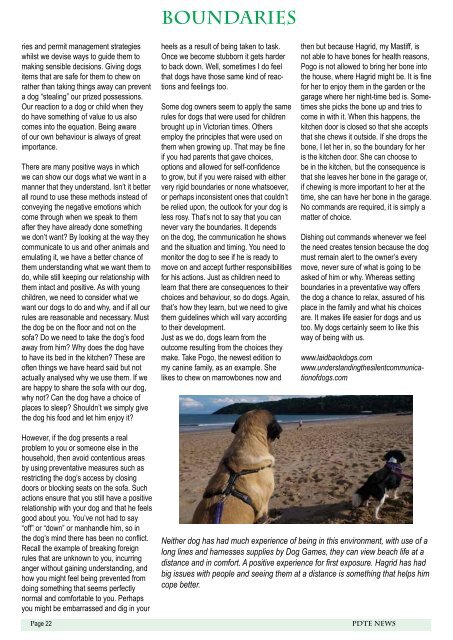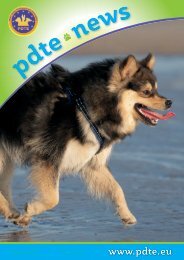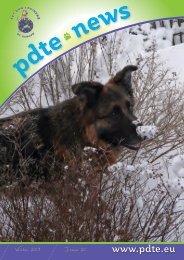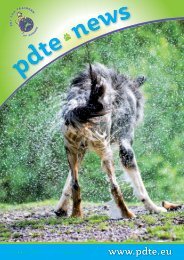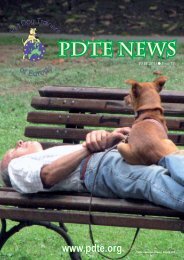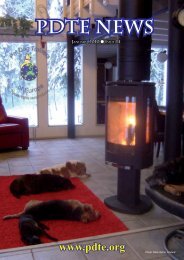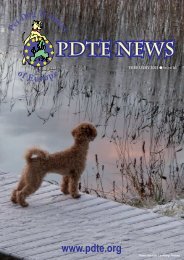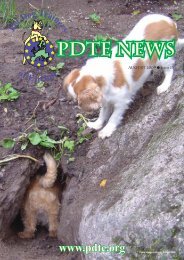PDTE 2012 October Newsletter
Create successful ePaper yourself
Turn your PDF publications into a flip-book with our unique Google optimized e-Paper software.
Boundaries<br />
ries and permit management strategies<br />
whilst we devise ways to guide them to<br />
making sensible decisions. Giving dogs<br />
items that are safe for them to chew on<br />
rather than taking things away can prevent<br />
a dog “stealing” our prized possessions.<br />
Our reaction to a dog or child when they<br />
do have something of value to us also<br />
comes into the equation. Being aware<br />
of our own behaviour is always of great<br />
importance.<br />
There are many positive ways in which<br />
we can show our dogs what we want in a<br />
manner that they understand. Isn’t it better<br />
all round to use these methods instead of<br />
conveying the negative emotions which<br />
come through when we speak to them<br />
after they have already done something<br />
we don’t want? By looking at the way they<br />
communicate to us and other animals and<br />
emulating it, we have a better chance of<br />
them understanding what we want them to<br />
do, while still keeping our relationship with<br />
them intact and positive. As with young<br />
children, we need to consider what we<br />
want our dogs to do and why, and if all our<br />
rules are reasonable and necessary. Must<br />
the dog be on the floor and not on the<br />
sofa? Do we need to take the dog’s food<br />
away from him? Why does the dog have<br />
to have its bed in the kitchen? These are<br />
often things we have heard said but not<br />
actually analysed why we use them. If we<br />
are happy to share the sofa with our dog,<br />
why not? Can the dog have a choice of<br />
places to sleep? Shouldn’t we simply give<br />
the dog his food and let him enjoy it?<br />
heels as a result of being taken to task.<br />
Once we become stubborn it gets harder<br />
to back down. Well, sometimes I do feel<br />
that dogs have those same kind of reactions<br />
and feelings too.<br />
Some dog owners seem to apply the same<br />
rules for dogs that were used for children<br />
brought up in Victorian times. Others<br />
employ the principles that were used on<br />
them when growing up. That may be fine<br />
if you had parents that gave choices,<br />
options and allowed for self-confidence<br />
to grow, but if you were raised with either<br />
very rigid boundaries or none whatsoever,<br />
or perhaps inconsistent ones that couldn’t<br />
be relied upon, the outlook for your dog is<br />
less rosy. That’s not to say that you can<br />
never vary the boundaries. It depends<br />
on the dog, the communication he shows<br />
and the situation and timing. You need to<br />
monitor the dog to see if he is ready to<br />
move on and accept further responsibilities<br />
for his actions. Just as children need to<br />
learn that there are consequences to their<br />
choices and behaviour, so do dogs. Again,<br />
that’s how they learn, but we need to give<br />
them guidelines which will vary according<br />
to their development.<br />
Just as we do, dogs learn from the<br />
outcome resulting from the choices they<br />
make. Take Pogo, the newest edition to<br />
my canine family, as an example. She<br />
likes to chew on marrowbones now and<br />
then but because Hagrid, my Mastiff, is<br />
not able to have bones for health reasons,<br />
Pogo is not allowed to bring her bone into<br />
the house, where Hagrid might be. It is fine<br />
for her to enjoy them in the garden or the<br />
garage where her night-time bed is. Sometimes<br />
she picks the bone up and tries to<br />
come in with it. When this happens, the<br />
kitchen door is closed so that she accepts<br />
that she chews it outside. If she drops the<br />
bone, I let her in, so the boundary for her<br />
is the kitchen door. She can choose to<br />
be in the kitchen, but the consequence is<br />
that she leaves her bone in the garage or,<br />
if chewing is more important to her at the<br />
time, she can have her bone in the garage.<br />
No commands are required, it is simply a<br />
matter of choice.<br />
Dishing out commands whenever we feel<br />
the need creates tension because the dog<br />
must remain alert to the owner’s every<br />
move, never sure of what is going to be<br />
asked of him or why. Whereas setting<br />
boundaries in a preventative way offers<br />
the dog a chance to relax, assured of his<br />
place in the family and what his choices<br />
are. It makes life easier for dogs and us<br />
too. My dogs certainly seem to like this<br />
way of being with us.<br />
www.laidbackdogs.com<br />
www.understandingthesilentcommunicationofdogs.com<br />
However, if the dog presents a real<br />
problem to you or someone else in the<br />
household, then avoid contentious areas<br />
by using preventative measures such as<br />
restricting the dog’s access by closing<br />
doors or blocking seats on the sofa. Such<br />
actions ensure that you still have a positive<br />
relationship with your dog and that he feels<br />
good about you. You’ve not had to say<br />
“off” or “down” or manhandle him, so in<br />
the dog’s mind there has been no conflict.<br />
Recall the example of breaking foreign<br />
rules that are unknown to you, incurring<br />
anger without gaining understanding, and<br />
how you might feel being prevented from<br />
doing something that seems perfectly<br />
normal and comfortable to you. Perhaps<br />
you might be embarrassed and dig in your<br />
Neither dog has had much experience of being in this environment, with use of a<br />
long lines and harnesses supplies by Dog Games, they can view beach life at a<br />
distance and in comfort. A positive experience for first exposure. Hagrid has had<br />
big issues with people and seeing them at a distance is something that helps him<br />
cope better.<br />
Page 22 <strong>PDTE</strong> NEWS


